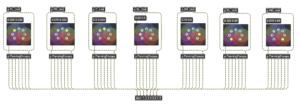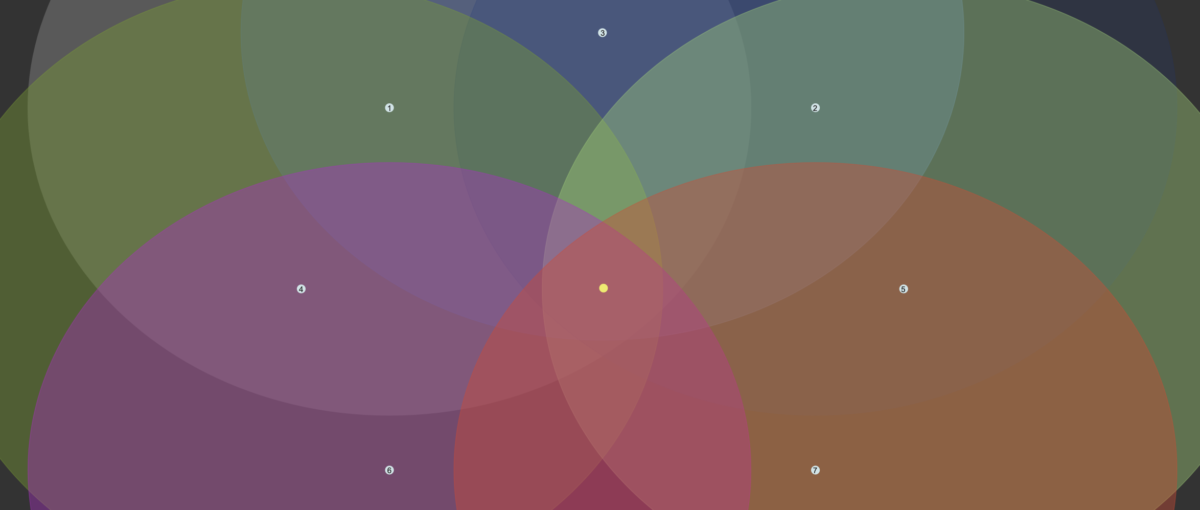The two last posts describe the signal flow of these sonification projects. We first reviewed its sonified granular re-synthesis and later the sonified heavy loop-processing performed in parallel. The repetition of these systems across the eight channels of a 7.1 surround sound layout was mentioned in both posts, a topic we shall now cover. Such concept, “7.1 surround sound”, not only describes the number of discrete output channels needed for this set-up but also includes a notion of spatial relationships between the qualities of these eight channels and the nature of their respective audio signals.
To successfully create a surround audio soundscape environment, breaking down the relationship between the listener and the soundscape is essential. The idea of soundscape positions any listener within itself, submerged in all directions, leading to the notion that the multitude of sources does not exclusively define the positional nature of a soundscape but, moreover, by the listener too. Even though the sense of direction, within the scope of the individual sonic event, comes from a single surrounding position, the grand composition of a soundscape is far more dependent on the listener’s location and orientation. The sonic place exists without the listener, yet to some extent, the listener defines how this is positionally perceived. On this note, it was mentioned in previous posts how the recording technique (2 pairs of A-B, facing opposite directions) of this soundscape defined a set of fixed positions, all with the same orientation. For each moment of the “stepped” recording, four positionally related audio files were produced together (Front-Left, Front-Right, Rear-Left and Rear-Right). Now the distribution across the eight channels of the 7.1 layout followed as such:
-
- Front-Left –> Recording: Front-Left
- Front-Right –> Recording: Front-Right
- Centre –> Recording: Front-Left + Front-Right (MONO)
- Side-Left –> Recording: Front-Left
- Side-Right –> Recording: Front-Right
- Rear-Left –> Recording: Rear-Left
- Rear-Right –> Recording: Rear-Right
- Subwoofer –> Recording: Front-Left + Front-Right (MONO)
Although the audio source layout was thought to be as described above, such a solution would still feel unnatural due to the discreetness per output channel. It would cause too harsh of a distinction between the different audio content. For example, the side channels would exclusively reproduce front-left/right recordings and no in-between with the rear ones. For a better solution, some 7-channel panning had to be designed to successfully mix gain values for each signal channel into correctly panned-out ones. As such, the design found a suitable answer by using node panels that can quickly provide a mix of values according to the relative position of a pointer, a solution found research on Cycle’74 Forums (Woodbury 2016). These panning systems were created for each of the 7.1 outputs using the same node layout with a respective pointer position. These panning units input an audio-file channel, like the ones listed above, and split into seven tracks of this audio signal with the correct gain values for each speaker position, providing an accurate, correct, smoother panned mix.

Once tuned to the room and the speaker set-up, this layout provided a surround sound environment emphasising a wide sonic front while keeping surrounding panoramic qualities with two dedicated rear channels. The output of these discrete channels was achieved using a [~dac 1 2 3 4 5 6 7 8] object, followed by dedicated volume faders.
With this 5th blog post, there is not much more on Sonification to document. However, the Max/MSP project designed for this effect later integrates the works of “interactive audio” and interfacing with visual components on a TouchDesigner domain. In these notes, more posts will follow through on these developments.
If you’re reading this in order, please proceed to the next post: ‘Sonification #6 – Project Files and Soundscape Demo’.
David Ivo Galego,
s2272270
REFFERENCES:
Woodbury L (13 April 2016) ‘Re: 7-channel Panning’ [Forum post comment], Cycling’74 Forums, accessed 23 March 2023.
